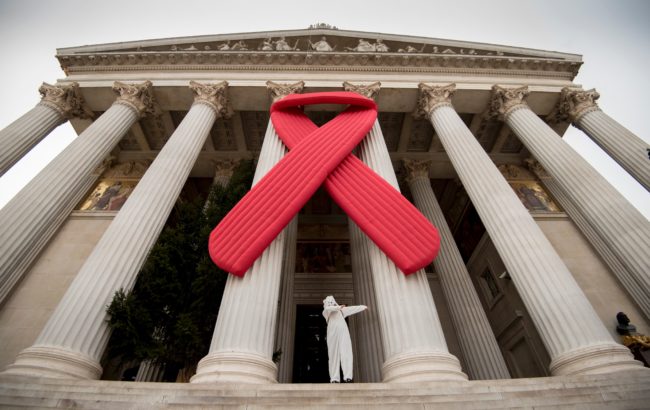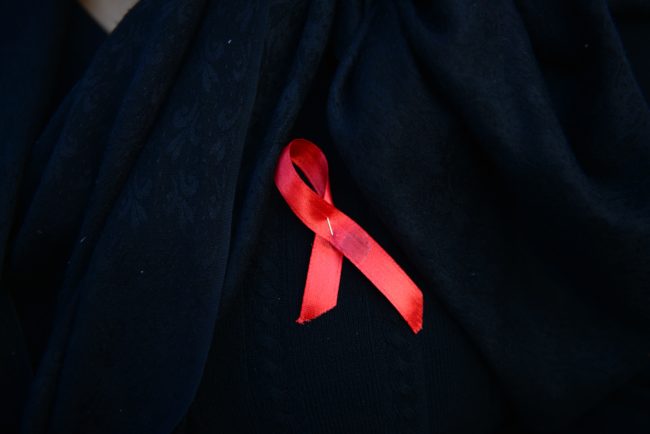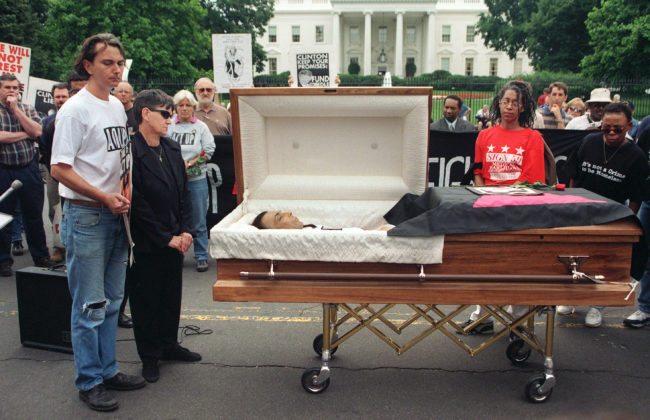New York Times addresses its ‘shameful’ coverage during AIDS crisis

The New York Times has addressed its poor history of covering HIV/AIDS during the AIDS crisis.
The newspaper came under heavily criticism from AIDS activists and the LGBT community over its “shameful” coverage of the AIDS epidemic in the 1980s, when New York City’s gay community was ravaged by the spread of the disease.
Media and politicians faced fury for their silence and slowness to act over what was seen as a ‘gay disease’, with one chilling recording featuring President Reagan’s press secretary laughing after being asked about gay people’s deaths.
President Reagan did not mention AIDS in public until 1985, when 5000 people – primarily gay and bisexual men – had already died.
AIDS activist Larry Kramer was vocally critical of the New York Times for its coverage, attributing deaths to the paper’s actions.

The Austrian Parliament decorated with a large AIDS ribbon (Photo by JOE KLAMAR/AFP/Getty Images)
In a piece published today, New York Times writer Kurt Soller addressed the newspaper’s coverage – more than 30 years on.
Soller wrote: “Any newspaper must, by definition, aspire to be the “paper of record,” and yet when it came to this newspaper’s coverage of gay people and AIDS in the early ’80s — when the disease was morphing into a national crisis, and when rights that had been won a decade earlier, after the Stonewall Riots, were once again being jeopardized — The Times’s own record was checkered at best.
“Information about the spread of illness was often scant, judgmental or distressingly vague — even while reporters on the Science desk were trying their best with an ever-evolving story. The social and emotional toll of AIDS and the resulting queer movement were, when covered, often buried in the back of the newspaper (on a page called Styles of the Times), far from national news stories that were deemed important enough for the front page.
“Famously, it would take President Ronald Reagan more than four years to acknowledge the disease publicly. And it took until 1983 for The Times to run an article about the disease on Page A1, two years after the first reports of symptoms.”
The newspaper invited six writers to reflect on its coverage.

(PRAKASH MATHEMA/AFP/Getty Images)
Economy reporter Natalie Kitroeff notes that “many employees felt that A.M. ‘Abe’ Rosenthal, the paper’s editor, was homophobic”, reflecting on internal battles over the use of terms like “admitted homosexuals”.
Media reporter John Koblin noted that there were 558 dead in the United States before the Times put the issue on the front page.
He added: “Roughly 700 editions of the paper had come and gone before AIDS, quickly turning into a full-fledged crisis, had earned a spot on Page One. It was never lost on AIDS activists just how vital the paper was — and for how long it did not pay serious attention to the disease.”
David W. Dunlap, a reporter in the Metro section at the time, told him: “There were strong messages that you got that were not written on any whiteboard. You knew to avoid it. It was a self-reinforcing edict: Don’t write about queers.”
Koblin added: “By the time The Times did give AIDS front-page attention, it did so with a bit of a stiff arm. Though public health officials were now going on the record to discuss the disease’s devastation, there was reluctance to discuss whom it affected most. In that first front-page story, it took seven paragraphs — which appeared after the jump, or inside the paper — to mention how hard it was hitting gay men.”

AIDS activists hold an open-casket funeral protest in front of the White House (JAMAL A. WILSON/AFP/Getty Images)
Washington correspondent Jeremy W. Peters wrote that even when it did cover the crisis, the newspaper often did unwitting harm.
He wrote: “They employed the same euphemisms, like ‘bodily fluids’, to substitute for words like semen, leaving the [false] impression that saliva from a kiss might infect you.”
The newspaper also recently launched an obituary project to recognise “overlooked” women, whose deaths the newspaper had not reported on during its 167-year history.
As part of the project Stonewall pioneer Marsha P. Johnson was finally given a obituary in the New York Times – more than 25 years on from her death.
The outlet added that Overlooked will become “a regular feature in the obituaries section”, as well as “expanding our lens beyond women”.

